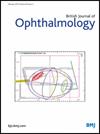Impact of glaucoma surgery on recurrence rate in cytomegalovirus anterior uveitis.
IF 3.5
2区 医学
Q1 OPHTHALMOLOGY
引用次数: 0
Abstract
BACKGROUND/AIMS In cytomegalovirus-induced anterior uveitis (CMV-AU), frequent recurrences are the primary cause of glaucomatous damage and corneal endothelial cell loss, yet factors influencing such recurrences remain unclear. Our study aims to investigate the impact of glaucoma surgery (GS) on recurrence rate in patients with CMV-AU. METHODS This retrospective study included 149 immunocompetent patients with CMV-AU treated with antiviral medication following PCR confirmation. Patients were divided into two groups: the surgery group, consisting of individuals who underwent GS (glaucoma filtering surgery (GFS) or glaucoma drainage device (GDD) implantation), and the medication group, comprising those managed with antiviral therapy alone. Recurrence rates, expressed as episodes per person-year (PY), were documented in the year prior to treatment initiation (from the symptoms onset to treatment start) and those occurring during or after treatment until the end of the follow-up period. RESULTS The median follow-up time was 29 months, with a total of 358 person-years (PYs) of follow-up. In the surgery group (n=24), 18 patients (75%) underwent GFS as initial GS, of whom 6 (33.3%) required additional GDD surgery within 1 year due to uncontrolled intraocular pressure. Recurrence rate dropped from 2.39 to 0.54 PYs in the surgery group (n=24), representing a 77.4% reduction (p=0.001). The medication group (n=125) saw a reduction from 2.92 to 1.20 PYs (58.9% reduction; p<0.001). Overall, recurrence rates were 0.45 times lower in the surgery group compared with the medication group (p<0.0001). Kaplan-Meier analysis showed a longer time to first recurrence in the surgery group (48.3 vs 20.5 months; p=0.006); however, corneal endothelial cell density decreased from 1801±629.5 cells/mm2 to 1522.9±715.8 cells/mm2 in the surgery group (p=0.046). CONCLUSION GS significantly reduced recurrence rate by 77.4% in patients with CMV-AU.青光眼手术对巨细胞病毒前葡萄膜炎复发率的影响。
背景/ aim巨细胞病毒诱导的前葡萄膜炎(CMV-AU)的频繁复发是青光眼损伤和角膜内皮细胞丢失的主要原因,但影响这种复发的因素尚不清楚。本研究旨在探讨青光眼手术(GS)对CMV-AU患者复发率的影响。方法回顾性研究149例CMV-AU免疫功能正常患者,经PCR证实,给予抗病毒药物治疗。患者被分为两组:手术组,由接受GS(青光眼滤过手术(GFS)或青光眼引流装置(GDD)植入的患者组成;药物组,由仅接受抗病毒治疗的患者组成。在治疗开始前一年(从症状出现到治疗开始)以及治疗期间或之后直到随访期结束时发生的复发率,以每人年(PY)的发作数表示。结果中位随访时间为29个月,总随访时间为358人年。在手术组(n=24)中,18例(75%)患者接受GFS作为初始GS,其中6例(33.3%)患者因眼压失控在1年内需要额外的GDD手术。手术组复发率从2.39个月下降到0.54个月(n=24),减少77.4% (p=0.001)。用药组(n=125)从2.92 PYs减少到1.20 PYs(减少58.9%,p<0.001)。总的来说,手术组的复发率比药物组低0.45倍(p<0.0001)。Kaplan-Meier分析显示,手术组首次复发时间较长(48.3个月vs 20.5个月;p=0.006);而手术组角膜内皮细胞密度由1801±629.5个细胞/mm2下降至1522.9±715.8个细胞/mm2 (p=0.046)。结论CMV-AU患者的复发率明显降低77.4%。
本文章由计算机程序翻译,如有差异,请以英文原文为准。
求助全文
约1分钟内获得全文
求助全文
来源期刊
CiteScore
10.30
自引率
2.40%
发文量
213
审稿时长
3-6 weeks
期刊介绍:
The British Journal of Ophthalmology (BJO) is an international peer-reviewed journal for ophthalmologists and visual science specialists. BJO publishes clinical investigations, clinical observations, and clinically relevant laboratory investigations related to ophthalmology. It also provides major reviews and also publishes manuscripts covering regional issues in a global context.

 求助内容:
求助内容: 应助结果提醒方式:
应助结果提醒方式:


